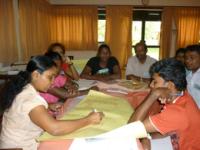
Field staff training for the size estimation study in Sri Lanka.
Credit: Dr. Ajith Karawita
HIV prevalence in the general population of Sri Lanka is very low at 0.1%. However data indicates that people who buy and sell sex and men who have sex with men are at risk of HIV infection yet little is known regarding the size of these groups making it difficult to guide the country’s HIV prevention efforts.
To build a baseline of strategic information, the Joint UN Team on AIDS at the request of the National STI/AIDS Control Programme in Sri Lanka, supported the development of a mapping and size estimation methodology for key populations. The World Bank provided technical assistance and UNFPA and UNAIDS gave top-up funding to ensure that communities in four districts could use the methodology.
The study’s findings, published in May 2010 estimate between 35 000 to 47 000 sex workers and between 24 000 to 37 000 men have sex with men in Sri Lanka.
Partnership key for effective HIV prevention
A constructive new partnership has emerged from the process. Representatives of men who have sex with men and sex workers met regularly with senior government officials from the Police and the Ministry of Health to implement the public health programme.
For the first time in Sri Lanka a public health issue is being addressed by non-traditional stakeholders who have come together for a common cause—the prevention of HIV among key populations at higher risk.
Dr Palitha Mahipala, Additional Secretary – Ministry of Healthcare and Nutrition
“For the first time in Sri Lanka a public health issue is being addressed by non-traditional stakeholders who have come together for a common cause—the prevention of HIV among key populations at higher risk,” said Dr Palitha Mahipala, Additional Secretary – Ministry of Healthcare and Nutrition and chair of the steering committee created to guide implementation.
Community groups were briefed by a team who worked on similar exercises in Pakistan and India who ensured that the methodology was adapted for easy use in Sri Lanka.
“Community members received excellent training on planning of field work, data collection, data entry, analysis and basic knowledge on micro planning for prevention services for sex workers from the University of Manitoba,” said Chandra Kanthi Abeykoon, Project Coordinator Community Strength and Development Foundation.
Filling the evidence gaps
This process has been a critical first step in building effective prevention for key populations at higher risk here in Sri Lanka.
David Bridger, UNAIDS Country Coordinator
The mapping was first undertaken in Colombo and Anuradhapura where initial results suggested that the numbers of sexually active men who have sex with men and sex workers were much higher than previously thought. According to the study team, participants from the community organizations appreciated the value of understanding exactly where hotspots for sex work are to ensure that HIV prevention programmes reach people in need of services.
Guarding the confidentiality of participants was a key concern in the project. In order to safeguard identities it was agreed that only community groups had access to the data with street names and locations which is relevant for prevention outreach activities.
The mapping was extended to Batticaloa and Nuwara Eliya. The National STD/AIDS Control Programme has used the broader averaged data from three of the districts to feed into the national estimates process where the country has been able to produce an evidence-based national estimate for key populations at higher risk for the first time.
During the project, the study team faced some challenges where local authorities intervened and questioned the exercise as it concerned behaviors that are regulated by punitive laws: both homosexuality and sex work are illegal in Sri Lanka. Members of the study team from the Ministry of Health and community organizations travelled to the research sites to meet with district officials to discuss and agree on the goals of the exercise.
Building momentum
Building on the prevention partnership established, the Government and civil society successfully applied for a grant from round 9 of the Global Fund to Fight AIDS, TB and Malaria. The grant, approved in early 2010, will enable the mapping exercise to be extended across the country and be complemented with prevention outreach to these key populations as well as to people who inject drugs, in prison settings.
“This process has been a critical first step in building effective prevention for key populations at higher risk here in Sri Lanka,” said David Bridger, UNAIDS Country Coordinator.
“A comprehensive package of prevention for key populations at higher risk in of HIV infection in Sri Lanka is a solid way of ensuring that HIV will remain at low levels in this country,” he added.
However barriers to effective prevention still remain and will continue to affect the implementation of the Government’s HIV prevention programme for key populations at higher risk over the next 5 years. Laws that criminalize certain behaviour push populations at higher HIV risk underground and away from HIV prevention services will need to be raised and more openly discussed.




 Field staff training for the size estimation study in Sri Lanka.
Field staff training for the size estimation study in Sri Lanka.